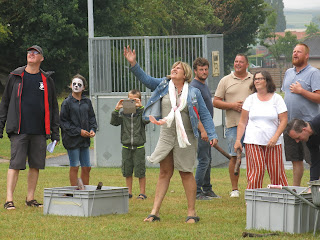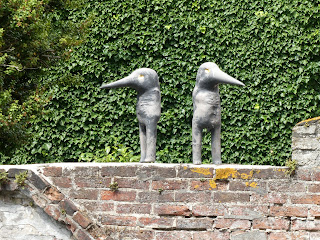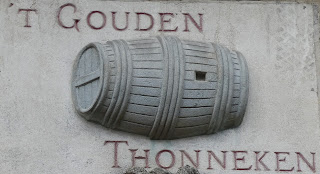After leaving Strasbourg and heading for Paris, we stopped in at
Reims along the way.
There are two things to do in Reims: drink champagne and visit the cathedral, Notre-Dame de Reims.
 |
| Mumms |
We weren't drinking, so we went to church. An ancient place, the first cathedral was thought to have been built in the 5th century. Over the ages, it has been built and rebuilt due to war and fires. The current building opened in in 1938, thanks in part to financial support from the Rockefellers,
It has very complex history includes the crowning of twenty-nine French kings, which led Joan of Arc to believe that the cathedral bestowed legitimacy, as she led her Gentle Dauphin to be crowned in Reims, despite the fact that Charles VII was the de facto King for seven years already.
In addition to classic Rose windows, there are glass panels designed by
Marc Chagall in 1974:
German artist
Imi Knoebel who refused payment for his work in designing this set of windows in 2015. More than a century after the German army intentionally shelled the Cathedral in WWI.
And
Brigitte Simon-Marq, whose work evokes light reflecting on a river. Of course, their installation in 1961 was opposed by the citizens of Reims.
 |
| Joan by Prosper d'Épinay, 1902 |
We found more to do. Starting with
La Musée des Beaux-Arts. Founded in 1794 with objects seized during the French Revolution, the building also has an interesting history. In the 9th century, construction started on the site of a cemetery for what was to be the Abbey of Saint-Denis. Since the Revolution, it also served as a warehouse for artworks from sold-off churches. From 1814 to 1815 it was a barracks for Russian occupation troops, and then in 1822 it was a grand seminary. Abandoned as a seminary in 1906 the museum moved into rooms that would have been the abbot's palace. After renovation, the present museum was re-opened in 1913. The collections cover all the main European artistic movements with special emphasis on
Lucas Cranach the Elder,
Camille Corot, and
Leonard Foujita.
 |
| Untitled by Maria-Helena Vieira da Silva, nd |
 |
| Jeaune Paysanne en buste by Aristile Mailoll, 1891 |
 |
| The Crows by Jean Dunand, 1936-39 |
 |
| Cats by Leonard Fujita, 1963 |
 |
| Paris-Montmartre Ordener by Leonard Fujita, 1939 |
Leonard Foujita was a Japanese born artist who went to Paris in 1913 and eventually became famous. The story goes that in 1959 he experienced enlightenment in Reims and was baptized at Notre Dame de Reims. His godfather was the chairman of Mumms champagne, so it is no surprise Foujita was soon designing a chapel which opened in 1966. Foujita himself painted on the walls at age 80. Though he died two years later, he was not re-interred at the chapel, as was his wish, until 2003.
We really didn't have much time in Reims, since we had to get to our apartment in
Paris that evening. This was a bit of an unplanned excursion and didn't have much more planned than following my
Modern Art Walking Tour of Paris (
CLICK HERE) to look for famous places and doorways, and mistakes I may have made. We were staying on the north side of the city, and began the next day at Place de Clichy, in Montmartre, Then on so many roads, alleys and boulevards to Montparnasse and back, that I will just include some random shots from the next couple of days.
 |
| Bourse columns by Lea Degez, 2019 |
 |
| Kiosk of the Night Walkers (Metro stop) by Jean-Michel Othoniel, 2000 |
Too many? Yes, but...
We were having record hot temperatures in Paris and our apartment did not have air condition, so after a couple of days of walking the city streets while trying to stay in the shade, we gave up and headed north, toward Belgium.
After recovering in a hotel in Lille, we moved on to
Heksenstoet - the Witches Parade in
Beselaire, Belgium. Their 60th, and quite a day.
It began on the damp side, but nothing could moisten the spirits of competitors who threw pieces of firewood at a clay pot up on a mast. Don't know why, but there was plenty of tasty refreshment.
Then there was the "soapbox derby" or something like that. Gravity-powered, home-made vehicles barreled down the wet street to the delight of the crowd.
And then it was time for the parade. A new event which began in 1959, they still have a lot of fun.
And more:
From our base in
Ledegem, we ventured west to the coast of Belgium. But on the way, we stopped at the
Brood & Banket Henk in
Ypres for their famous bread pudding. Just 40 cents a square and amazingly dense. And delicious.
Our destination was the seaside town of
Oostduinkirke. Where, at low tide, men ride their Belgian draft horses out into the surf to dredge for shrimp. The women skip the horses and dredge by hand.
And, of course, there is sculpture:
 |
| by Margaret van Nuffle |
 |
| Black Widows by Kenny Cotman, 2012 |
 |
| Jumping children in the wave by Ivan Peel, 2010 |
 |
| Cloned Paardenvisser by William Sweetlove |
 |
| Graag Traag (slow please) |
Another day we drove to the coast of France, and the town of
Gravelines, where they have erected sculptures in the moat of the old Vauban fortress.
 |
| La conversation by Charles Gadenne, 1977-80 |
 |
| La Liberte by Magda Nemeth, 1991 |
But, on the way, we found this piece of art in
Vlamertinge:
 |
| Agonie by Luc Coomans, 2013 |
And then we passed through
Poperinge, a town of many sculptures.
 |
| Fontein by Lucien de Gheus, 1958 |
 |
| Elaine Cossey by Nele Boudry, 2015, |
 |
| De Brouwer by Adhemar Vandromme, 1987 |
 |
| Watou by Hugo Heyrman, 1988. |
 |
| Meester Ghybe by Lucien De Gheus, 2005 |
Outside of Gravelines, we found
Sir Anthony Caro's
Chapel of Light in the village of
Bourbourg. Inaugurated in 2008, Caro's work was in the choir of the Church of St Jean Baptiste, which burned when, during the war, a damaged English aircraft crash-landed on the roof of the church in order to avoid the houses in the town. The church itself was restored, but the choir was left in ruins until the English sculptor was commissioned by the French Ministry for Culture and Communication to make a sculptural installation.
 |
| Adam and Eve |
Another day we drove up to
Brugge, where we have visited several times in the past, but cannot resist the allure of drinking Leffe bruin on tap in an ancient tavern.
 |
| by Joz de Loose |
Established in 1515, Café Vlissinghe is well hidden, and not always open. But they claim to be "Probably the oldest pub in the world."
Finally, the
Coming World, Remember Me exhibition in Belgium stands in memory of the thousands who died there. From 2014 to 2018,
Koen Vanmechelen directed the creation of 600,000 sculptures out of clay, with thousands of people from across Flanders and the rest of the world take part.
In March 2018 it was unveiled in Palingbeek park (Zillebeke), the site of one of the most intensive battles ever in Flanders. Afterwards, people took them home and we saw them in two of our stopovers.
Next: Return to Nederlands.
END OF BELGIUM AND FRANCE












































































































No comments:
Post a Comment